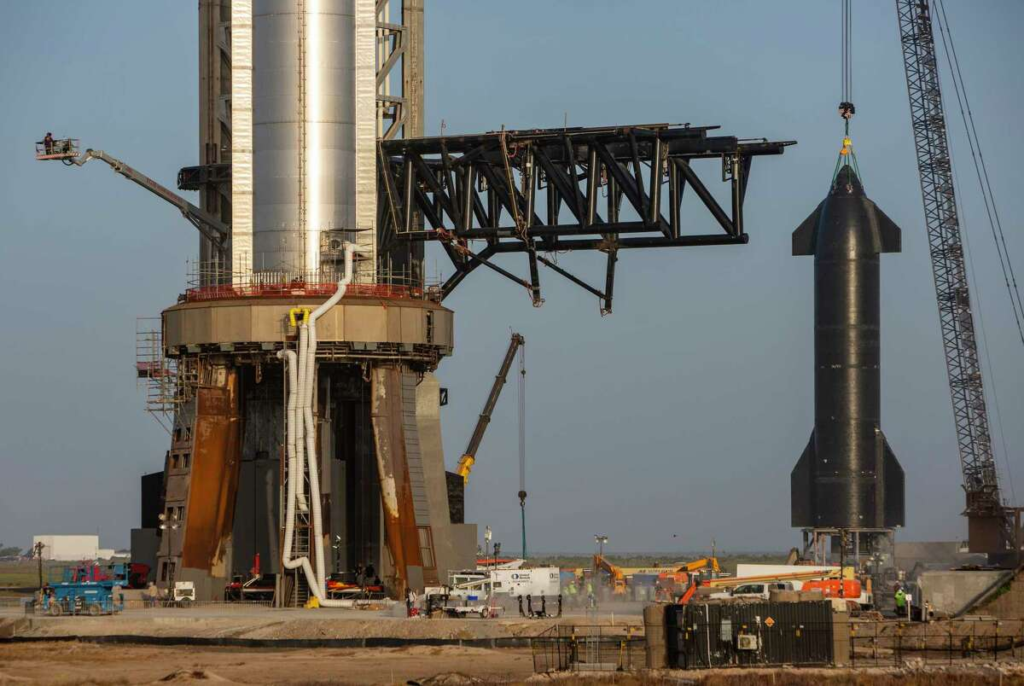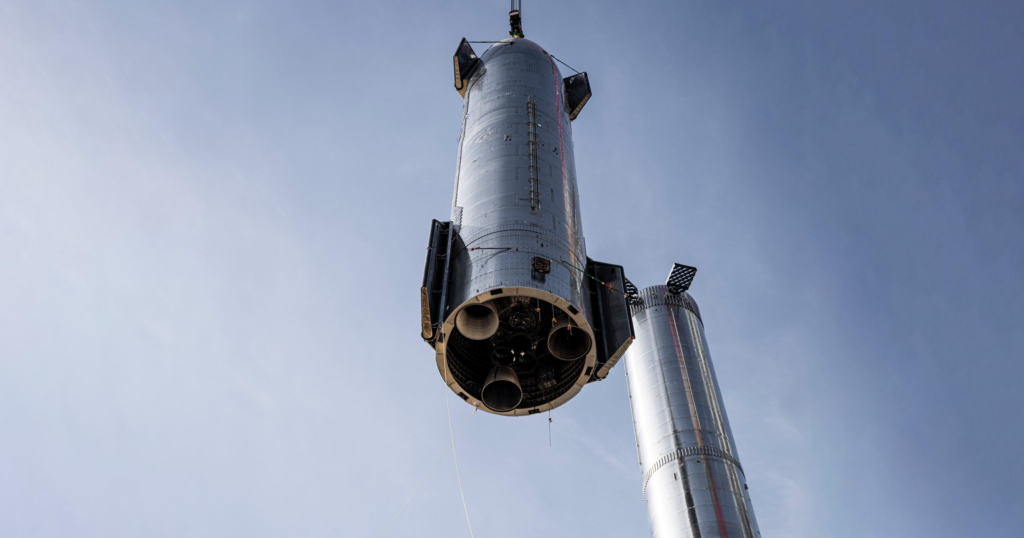
SpaceX Just Installed Starship’s Flight Termination System
At this point, we are only days away from Starship’s second integrated test flight based on recent updates. Just this morning, workers moved and installed the Flight Termination System explosives on Starship. This is one of the final steps before launch and something SpaceX only does when a mission is about to happen.
Combine this with the recent official update from SpaceX saying they are targeting the middle of November and this vehicle could be just about ready to lift off. The only thing the company has been waiting on is approval from the Fish and Wildlife Service. However, by now agency officials have already been to the site and inspected components of Stage 0 such as the water deluge system. This suggests that approval could be complete and soon to be announced.
If so, SpaceX would be ready to launch in just days as they have already completed all the necessary pre-launch testing. With the FTS explosives now installed, the rocket needs to be stacked and then it’s ready for a second mission. Here I will go more in-depth into the FTS installation, final launch prep, what to expect on this second flight, and more.
FTS Installation

Earlier this morning we got images of four workers carrying explosives headed toward Starship. A zoomed-in image highlights the 1.1D class label on the back indicating that these are indeed explosives. Not long after arriving, they moved to the crane arm around the FTS placement area of Booster 9. This suggests that they installed these explosives on the launch vehicle in preparation for launch.
What’s important to point out is that its possible SpaceX is not allowed to install these explosives unless they have a launch license. An official FAA statement is quoted saying, “Pre-flight ground operations” shall mean SpaceX’s pre-flight preparations of the Starship-Super Heavy vehicle at Boca Chica, Texas, beginning at the start of Autonomous Flight Termination System ordnance installation for the Starship upper stage vehicle or Super Heavy booster vehicle, whichever occurs first.” In other words, this morning’s developments would mean that SpaceX is approved for flight or at least heard something and will likely announce sometime soon.
This makes sense as you don’t place a bunch of explosives on a rocket when there are still months left of work. The only reason these would be installed is if SpaceX got some good news and knows it will at least be attempting a launch within a few days or so.
The specific reason for these explosives is to protect range and flight personnel along with surrounding area populations. Essentially, if a missile or space launch vehicle flies on a range in the United States, it must have a flight or thrust termination system (FTS). In the case that things go wrong during flight and the vehicle loses control, for example, the termination system will be activated exploding the launch vehicle in the air. This is a much safer result than in this case, the most powerful rocket in the world heading back toward the ground.
On the first integrated test flight, the Autonomous Flight Safety System (AFSS) automatically issued a destruct command, which fired all detonators as expected, after the vehicle deviated from the expected trajectory, lost altitude, and began to tumble. However, on the first flight, there was an unexpected delay and it took longer than SpaceX had planned for the vehicle to detonate. They were quoted saying, “After an unexpected delay following AFSS activation, Starship ultimately broke up 237.474 seconds after engine ignition. SpaceX has enhanced and requalified the AFSS to improve system reliability.”
Recently the company said in a statement, “The second flight test of a fully integrated Starship could launch as soon as mid-November, pending regulatory approval.” Current estimates and various sources believe November 15th will be the first attempt. For example, yesterday during the CRS-29 briefing SpaceX’s Benji Reed confirmed that the next Starship launch attempt is still on track for “mid-November”. This briefing occurred only a few days ago which means the company still is confident that it will launch in a few days. All good signs for the second integrated test flight and possible approval for the mission.
The Goal For IFT-2

If this second flight goes perfectly, both the Super Heavy booster and the Starship upper stage will impact the ocean. Specifically, once separated, the booster boostback startup burn commences 3 minutes and 11 seconds after liftoff. For the next whole minute, this burn continues until T + 4 minutes and 6 seconds. For the next couple of minutes, the booster will fall back toward Earth picking up a significant amount of speed. At T + 7 minutes and 40 seconds, the booster landing burn startup occurs. This burn will last for the next 31 seconds before its cutoff and the booster falls into the ocean in the Gulf of Mexico.
As for the upper stage, at T + 9 minutes and 20 seconds, Starship cuts off its engines. For the next hour and 8 minutes, the upper stage will be in its coast phase. This is until T + 1 hour and 17 minutes when Starship begins to enter the atmosphere. 11 minutes after the start of reentry and the vehicle is transonic. Finally, a full 1 and a half hours after liftoff, the Starship upper stage is expected to splash down in the Pacific Ocean. This is the exact flight profile assuming everything goes perfectly. In a perfect world, this is what happens on the second flight, however, SpaceX has a more realistic goal in mind.
In this case, there are two main objectives that will determine the success of this second flight. The first will be clearing the tower. While this may not seem like a big achievement, it’s important primarily for the reason of ensuring other flights can happen soon after. If Starship, the most powerful rocket in the world explodes on the pad or while still near it, it will destroy a lot of the surrounding infrastructure including the tower, orbital launch mount, new water-cooled steel plate, and likely damage nearby structures. To put it in perspective, on the first launch, Starship managed to clear the tower, however, the lack of proper pad infrastructure caused some significant damage to the pad, tanks, and various structures. If this much damage was caused by a faulty launchpad, an actual explosion on the pad would not be good. This would also result in another 6-12 months of work in order to repair the infrastructure at Stage 0, delaying a third flight of Starship.
On the second flight, if Starship does clear the tower, it will soon attempt its second objective, and what SpaceX is primarily aiming to complete, Stage separation. This was one point of failure on the first flight as the vehicle failed to separate and soon began to spin out of control before the flight termination system was activated. This had to do with internal fires and engine issues among other issues. In addition to this being a problem with the first flight, SpaceX also made some changes to this process that they want to test.
The company said in a statement, “SpaceX is also implementing a full suite of system performance upgrades unrelated to any issues observed during the first flight test. For example, SpaceX has built and tested a hot-stage separation system, in which Starship’s second-stage engines will ignite to push the ship away from the booster. Getting past this point which will happen around 2 minutes and 40 seconds info flight, would be a big milestone for the company and Starship’s development.
Before the first test flight, Elon Musk, SpaceX’s founder and CEO, said before the launch that a successful test flight would mean the rocket didn’t blow up on the launch pad. This time around that is still the goal but with some extra developments.
Besides the new stage separation approach, SpaceX has engineered a new electronic Thrust Vector Control (TVC) system for Super Heavy Raptor engines. Using fully electric motors, the new system has fewer potential points of failure and is significantly more energy efficient than traditional hydraulic systems. SpaceX also made significant upgrades to the orbital launch mount and pad system in order to prevent a recurrence of the pad foundation failure observed during the first flight test. These upgrades include significant reinforcements to the pad foundation and the addition of a flame deflector, which SpaceX has successfully tested multiple times. Grated those tests were partial thrust, however, the results were still promising.
In a final quote, the company says, “Testing development flight hardware in a flight environment is what enables our teams to quickly learn and execute design changes and hardware upgrades to improve the probability of success in the future. We learned a tremendous amount about the vehicle and ground systems during Starship’s first flight test. Recursive improvement is essential as we work to build a fully reusable launch system capable of carrying satellites, payloads, crew, and cargo to a variety of orbits and Earth, lunar, or Martian landing sites” they said. Within the next 48 hours or so we can expect to hear more information from either SpaceX or the FAA on possible approval and a launch date. If they have been approved for launch, then a week from now on November 15th could be the attempt.
Conclusion
SpaceX looks to have installed the Flight Termination System explosives on the Starship test article. If this is the case, they have been approved for launch and will attempt IFT 2 in only days. It’s been around half a year since the first flight and SpaceX has been very busy since then. We will have to wait and see how it progresses and the impact it has on the space industry.
